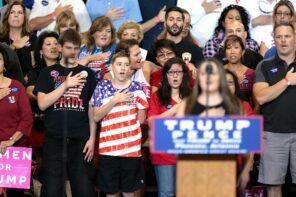Since election night, many have blamed the media for normalizing racism, misogyny, homophobia and xenophobia in their coverage of the election campaign. Those criticisms have only sharpened since President-Elect Trump’s announcement this weekend that Breitbart News chairman, Steve Bannon, would be his chief strategist. Critics have called on the media not to soften Bannon’s role in promoting anti-Semitism and racism through Breitbart. As mainstream media grappled with its framing, either referencing Bannon as “fringe,” or “provocative,” or simply an alt-right leader, the alt-right and white nationalists are celebrating his appointment.
Throughout the campaign itself reporters faced verbal attacks while assembled in the media pen at Trump rallies. Reporters were the target of racist and sexist attacks on social media, as Trump supporters’ anger and mistrust with mainstream media became a core element of the billionaire’s campaign.
Calls for accountability from the media are not misplaced. There is a need for mainstream media to be especially careful about normalizing and softening figures like Bannon, as well as to reflect on their role in the election of Donald Trump with his often deplorable campaign platform. Yet, this focus on the mainstream media is emblematic of the divide between the left and the right in America. We need to look at the media Trump voters were reading and watching and ask for accountability from those media sources.
Trump himself understands this divide. After appearing on 60 Minutes for his first interview as President-Elect, Trump will appear on right wing conspiracy theorist Alex Jones’ InfoWars to thank his supporters.
Right-wing media has long been on the periphery. During the Goldwater campaign media focus on right-wing publications was primarily on William F. Buckley Jr.’s National Review, though it wasn’t the main source of media for the “extremists” on the right. Human Events, American Opinion, and a myriad of newsletters and tract publications were the ones who really brought the issues to Goldwater supporters.
These newsletters, created primarily by suburban housewives, and some, such as The Network of Patriotic Letter Writers, had a significant audience reach. They were essentially the blogs and discussion forums of their day. These missives included copies of newspaper articles that supported culture war issues of the day, some conspiracy theories, calls for action (such as petitions, boycotts, letter writing campaigns), quotes from the Bible, and prayers to “Save America.” The writers linked religion to current events, with calls for a return to “traditional American values,” and as a tool to stop Communism in America.
A quick Google search reveals both underground and large media outlet writings similar to these newsletters from the 50s and 60s. Hashtags, such as #RedNationRising, exist on twitter for the dissemination of these e-zines, blogs and forums. Not much has changed. Quotes from the Bible, prayers for America, conspiracy theories and, most importantly, the anger bubbling up from these individuals, are the focus of these virtual newsletters. The feelings of disenfranchisement, of being voiceless, and not accepted are almost visceral in these publications. This is Trump’s America; Trump’s media. This isn’t the media that the majority is asking to be accountable.
Simultaneously, conservative religious leaders are also utilizing media to speak directly to Trump’s electorate. The night of the election, Pastor John Haggee hosted a live Facebook video for followers to ask specific questions about religion and the election. Family Research Council President Tony Perkins tweeted about “freedom and America” after their live election broadcast on Facebook. He also provided a link to a post on how to speak to your children about the election (step one is to explain that God ultimately appoints every president).
These ministries and organizations use social media, live broadcasts, blogs and forums to reach their audiences about political issues, nominees who support their culture war issues, and most importantly link these topics to their faith. Organizations such as CNSNews, a division of Media Research Center, “Seeks to bring you the news the leftist media won’t cover.” They have an audience of over 100,000.
Brent Bozell, Founder and President of Media Research Center, released a statement on the election and mainstream press:
This was a massive repudiation of the press. Our message –‘Don’t Believe the Liberal Media’ succeeded, and in the next few days we will be unveiling a massive amount of polling data that will document this empirically
While the left is questioning mainstream media, right-wing media is celebrating its success, largely unchallenged (and unnoticed) by the rest of the public. From large-scale live video productions to newsletters written by individuals, right-wing media successfully linked God, politics and culture war issues to help mobilize a substantive electorate for Trump.
In the aftermath of the election and our questioning of media, perhaps we need to look further than the mainstream, as it has already been dismissed and ignored by many who have leveraged their power to help elect a nominee like Donald Trump. Conversely, while many ask if the appointment of Bannon will effectively make Breitbart News an arm of a Trump presidency’s media outreach, the alt-right is slowly becoming an aspect of pop culture as AdultSwim announces its newest production, an alt-right comedy.





